Changing a baby’s diaper is a crucial part of their daily routine. However, many new parents often find themselves wondering if they should change their baby’s diaper while they’re sleeping. It’s a common question that should I change diaper if baby is sleeping.
The answer to this question is not straightforward and may vary depending on different factors, such as the baby’s age, diaper type, and their comfort level. Understanding the baby’s sleep patterns and the basics of diaper changing can help parents make an informed decision about whether or not to change their baby’s diaper while they’re sleeping.
Key Takeaways
- Changing a baby’s diaper while they’re sleeping may not always be necessary and depends on various factors, including the baby’s age, diaper type, and comfort level.
- Understanding the baby’s sleep patterns and the basics of diaper changing can help parents make an informed decision about whether or not to change their baby’s diaper while they’re sleeping.
- It’s essential to prioritize the baby’s comfort and hygiene while changing their diaper and to be mindful of potential risks associated with not changing the diaper timely.
Understanding Baby’s Sleep Patterns
Understanding a baby’s sleep patterns is essential for any parent, especially when it comes to changing their diaper. Babies sleep a lot, and their sleep patterns can be different from adults. Here are a few things to keep in mind when it comes to understanding a baby’s sleep patterns:
- Newborns sleep a lot: Newborns sleep for around 16-17 hours a day and wake up every few hours to feed. They usually sleep in short bursts of 2-3 hours at a time.
- Nighttime sleep patterns: Nighttime sleep patterns can be different from daytime sleep patterns. Babies tend to sleep longer at night, and their sleep is deeper. They may also wake up less often at night.
- Sleep cycles: Babies have shorter sleep cycles than adults, which means they can wake up more often during the night. It’s normal for babies to wake up every few hours to feed or be changed.
- Sleep associations: Babies can develop sleep associations, which means they associate certain things with sleep. For example, they may associate being rocked with falling asleep. It’s important to establish healthy sleep associations early on to help your baby develop good sleep habits.
- Sleep regressions: Sleep regressions are periods when a baby’s sleep patterns change. They can happen at different ages and can be caused by a variety of factors, such as teething or developmental milestones.
When it comes to changing a baby’s diaper while they’re sleeping, it’s important to keep in mind their sleep patterns. If your baby is sleeping soundly and doesn’t need a diaper change, it’s best to let them sleep. However, if your baby wakes up for a feeding or needs a diaper change, it’s important to attend to their needs promptly to ensure they stay comfortable and dry.
The Basics of Diaper Changing
Diaper changes are an inevitable part of parenting, and it’s important to know how to do it properly. Whether it’s your first time changing a baby’s diaper or you’re a seasoned pro, there are a few basic steps to follow.
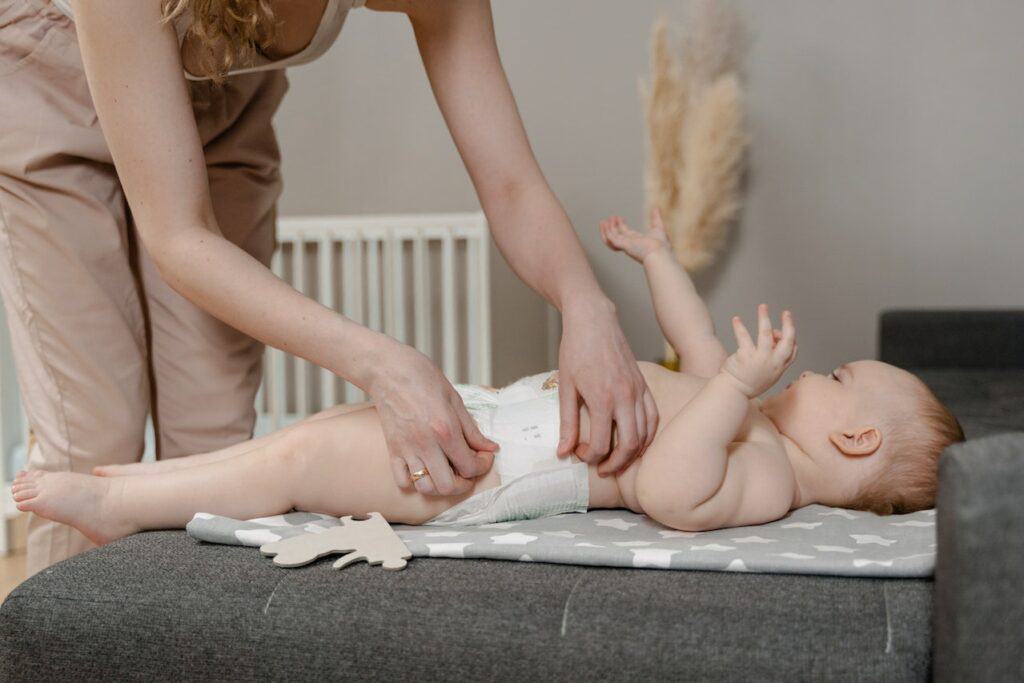
First, gather all of the necessary supplies, including a clean diaper, wipes, diaper rash cream, and a changing pad or towel. It’s important to have everything within reach to avoid leaving the baby unattended.
Next, lay the baby down on the changing pad or towel and undo the dirty diaper. Use wipes to clean the baby’s diaper area thoroughly, making sure to wipe from front to back for girls to avoid infection. If the baby has a diaper rash, apply diaper rash cream.
Once the baby is clean, slide a clean diaper underneath them, making sure the tabs are at the back. Bring the front of the diaper up between the baby’s legs and secure the tabs on each side. Make sure the diaper is snug but not too tight, and check to see if it’s on straight.
When changing a baby’s diaper at night, it’s important to keep the lights low and avoid stimulating the baby too much. Use a nightlight or a soft light to see what you’re doing, and avoid talking or playing with the baby.
In summary, changing a baby’s diaper involves a few basic steps: gather supplies, clean the baby’s diaper area, apply diaper rash cream if necessary, and put on a clean diaper. When changing a diaper at night, keep the lights low and avoid stimulating the baby too much. With practice, diaper changes will become second nature and you’ll be able to do them quickly and efficiently.
When to Change a Diaper
Changing diapers is an essential task when taking care of a baby. However, parents may wonder when it is necessary to change a diaper, especially when the baby is sleeping.
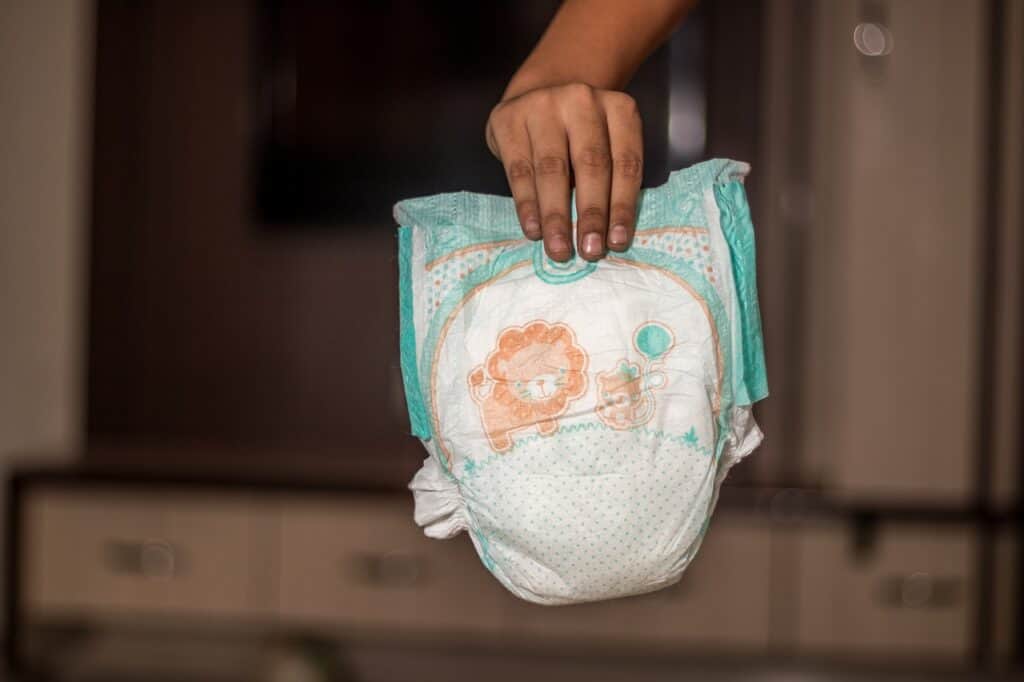
1. Wet Diapers
A wet diaper is a common reason for changing a baby’s diaper. Wet diapers can cause discomfort to the baby, leading to irritability and crying. It is recommended to change a wet diaper as soon as possible to keep the baby comfortable and prevent diaper rash.
2. Dirty Diapers
Dirty diapers are another reason for changing a baby’s diaper. A soiled diaper can cause discomfort and irritation to the baby’s skin and can lead to diaper rash. It is recommended to change a dirty diaper as soon as possible to keep the baby clean and comfortable.
3. Night Diaper Changes
Nighttime diaper changes can be a challenging task for parents, especially when the baby is sleeping. However, it is essential to change the baby’s diaper at night to prevent discomfort and keep the baby clean. Parents can consider using night diapers that are designed to last longer and provide better absorbency, reducing the need for frequent diaper changes.
4. Age
The frequency of diaper changes may vary depending on the baby’s age. Newborns may require more frequent diaper changes as they tend to pee and poop more often. As the baby grows older, the frequency of diaper changes may decrease.
In conclusion, it is important to change a baby’s diaper when it is wet or dirty to keep the baby comfortable and prevent diaper rash. Nighttime diaper changes are also necessary to prevent discomfort and keep the baby clean. The frequency of diaper changes may vary depending on the baby’s age.
Diaper Types and Their Absorbency
When it comes to choosing the right diaper for your baby, absorbency is a crucial factor to consider. Diapers come in different types, each with varying levels of absorbency. Here are some of the most common diaper types and their absorbency capabilities:
Cloth Diapers
Cloth diapers are made of natural fibers such as cotton, hemp, and bamboo. They are reusable and can be washed and dried for multiple uses. Cloth diapers are available in different sizes and styles, including prefolds, flats, and fitted diapers. They are generally less absorbent than disposable diapers and may require more frequent changes to prevent leaks.
Disposable Diapers
Disposable diapers are made of synthetic materials and come in various sizes and styles. They are designed to be used once and then thrown away. Disposable diapers are highly absorbent and can hold large amounts of liquid, making them ideal for overnight use. They also come with features such as wetness indicators and elastic leg cuffs to prevent leaks.
Diaper Cream
Diaper cream is a topical ointment used to prevent and treat diaper rash. It creates a barrier between the baby’s skin and the diaper, protecting the skin from irritation and moisture. Diaper creams come in different formulations, including zinc oxide, petroleum jelly, and lanolin. They should be applied sparingly to avoid interfering with the diaper’s absorbency.
In conclusion, choosing the right diaper type and size is crucial to ensure your baby stays clean, dry, and comfortable. Understanding the absorbency capabilities of different diaper types can help you make an informed decision and prevent diaper rash and leaks.
Potential Risks of Not Changing Diapers
Leaving a baby in a wet or dirty diaper for too long can lead to potential risks. The following are some of the risks that may arise if a diaper is not changed promptly:
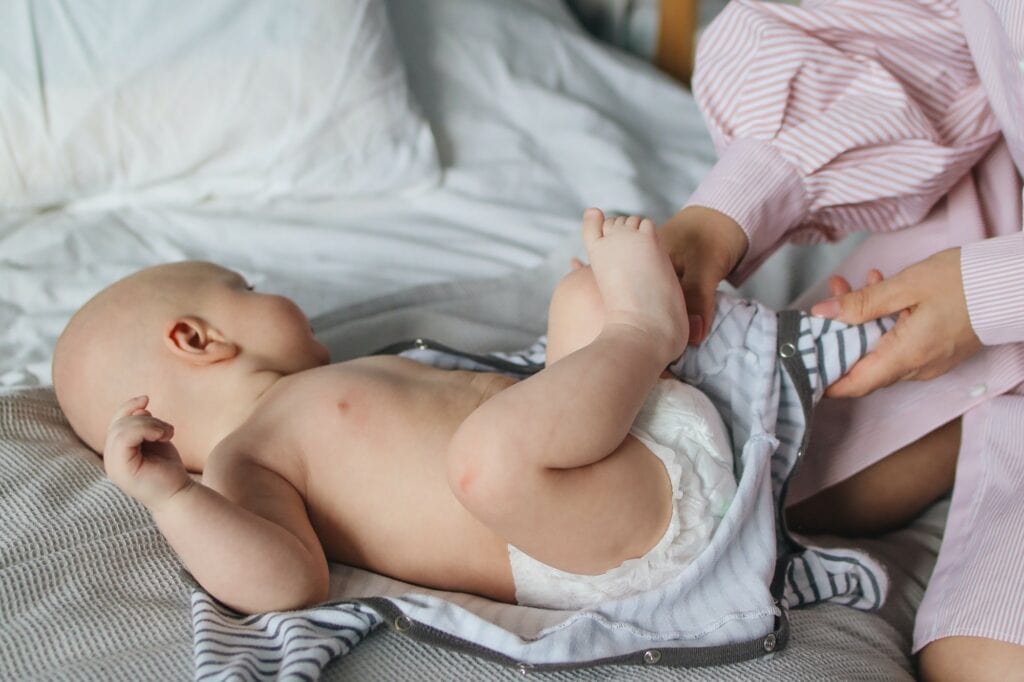
1. Skin Irritation and Chafing
When a baby’s skin is exposed to urine and feces for an extended period, it can cause irritation and chafing. The skin may become red, sore, and inflamed, making the baby uncomfortable and fussy.
2. Bacterial Infections
Bacteria thrive in warm and moist environments, and a wet diaper provides the perfect breeding ground. If a diaper is not changed promptly, bacteria can multiply and cause infections. This can lead to urinary tract infections, skin infections, and other gastrointestinal issues.
3. Fungal Infections
Prolonged exposure to a wet diaper can also cause fungal infections, such as diaper rash and thrush. These infections can be painful and cause discomfort to the baby.
4. Dehydration
Urine and feces contain a lot of water, and when a baby is left in a wet diaper for too long, they can lose a significant amount of fluids. This can lead to dehydration, which can be dangerous for infants.
5. Rubbing and Discomfort
A wet diaper can cause rubbing and discomfort, leading to a fussy and irritable baby. The baby may cry and have trouble sleeping, making it difficult for both the baby and the caregiver.
In conclusion, changing a baby’s diaper promptly is essential to prevent potential risks such as skin irritation, bacterial and fungal infections, dehydration, and discomfort. It is important to check the diaper frequently and change it as soon as it becomes wet or soiled.
Nighttime Diaper Changes
Many parents wonder if they should change their baby’s diaper during the night while they are sleeping. While it may seem like a good idea to let your baby sleep through the night without interruption, it is important to remember that a wet or soiled diaper can cause discomfort and even lead to diaper rash.
Some parents opt to use overnight diapers, which are designed to absorb more liquid and provide extra protection during the night. These diapers can be a great option for parents who want to minimize nighttime diaper changes.
However, if your baby is prone to diaper rash or has sensitive skin, it may be necessary to change their diaper during the night to prevent irritation. It is important to keep the diaper area clean and dry to avoid diaper rash.
When changing your baby’s diaper at night, it is important to keep the lights low and avoid stimulating your baby too much. Keep the diaper changing routine as quick and quiet as possible to avoid waking your baby up fully.
To make nighttime diaper changes easier, consider setting up a changing station in your bedroom or near your baby’s crib. Keep all necessary supplies within reach, such as diapers, wipes, and diaper cream.
Overall, whether or not to change your baby’s diaper during the night is a personal decision that depends on your baby’s individual needs. While some babies may be able to sleep through the night without a diaper change, others may require a change to prevent discomfort and diaper rash.
Feeding and Diaper Changes
When it comes to feeding and diaper changes, parents often wonder whether they should change their baby’s diaper if they are sleeping. The answer to this question is not a simple yes or no, as it depends on several factors.
Firstly, if the baby is dry and has not soiled the diaper, there is no need to change it. However, if the baby has wet or soiled the diaper, it is essential to change it as soon as possible, even if the baby is sleeping. Leaving the baby in a wet or soiled diaper can cause discomfort and lead to diaper rash.
For breastfed babies, it is recommended to change the diaper before feeding to ensure that the baby is comfortable and not distracted during feeding. On the other hand, for bottle-fed babies, it is recommended to change the diaper after feeding as they may fall asleep during feeding and may need a diaper change afterward.
Parents should also consider the baby’s reflux condition. If the baby has reflux, it is best to change the diaper before feeding to prevent the baby from spitting up during feeding.
In conclusion, it is essential to change the baby’s diaper as soon as possible if it is wet or soiled, even if the baby is sleeping. For breastfed babies, it is best to change the diaper before feeding, while for bottle-fed babies, it is best to change the diaper after feeding. Parents should also consider the baby’s reflux condition when deciding when to change the diaper.
Tips and Tricks for Changing Diapers
Changing diapers can be a daunting task for new parents, especially when the baby is sleeping. Here are some tips and tricks to make the process easier and more efficient.
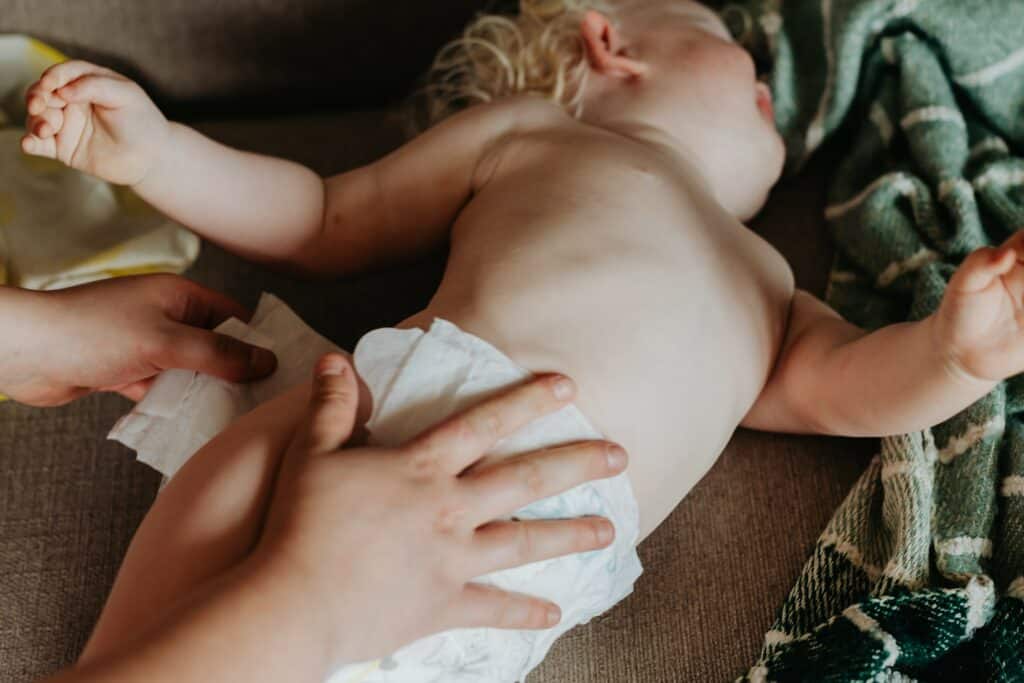
Use the Right Wipes
Choosing the right wipes can make a big difference. Look for wipes that are gentle on the baby’s skin and free from harsh chemicals. The American Pregnancy Association recommends using unscented, alcohol-free wipes.
Monitor the Baby
It’s important to keep an eye on the baby while changing their diaper, even if they are sleeping. Use a baby monitor to keep track of their movements and sounds. This will help you know when to change their diaper and prevent any accidents.
Be Prepared for Urination
Babies often urinate during diaper changes, so be prepared for it. Place a clean diaper under the baby before removing the soiled one. This will prevent any messes and make the process smoother.
Ensure a Good Fit
A good-fitting diaper is essential to prevent leakage and ensure the baby’s comfort. Make sure to choose the right size for your baby and adjust the tabs for a snug fit.
Use Tricks to Keep the Baby Calm
Some babies may wake up during a diaper change and become fussy. Use tricks like singing, talking, or using a toy to keep them calm and distracted.
Consider a Smart Diaper
Smart diapers like Lumi can help make the diaper-changing process easier. They come with sensors that track the baby’s diaper usage and alert you when it’s time for a change.
By following these tips and tricks, parents can change their baby’s diaper with confidence and ease, even when the baby is sleeping.
Baby’s Comfort and Diaper Changes
When it comes to changing a baby’s diaper, parents often wonder if they should change it while the baby is sleeping. One of the main concerns is whether or not it will disturb the baby’s sleep and affect their comfort.
Babies need to feel comfortable and secure in order to sleep soundly. A wet or dirty diaper can cause discomfort and disrupt their sleep cycle. However, changing a diaper can also be disruptive, especially if the baby is in a deep sleep.
To minimize disruption, parents can try swaddling their baby before changing their diaper. Swaddling can help create a sense of security and calmness, making it easier for the baby to fall back asleep after the diaper change.
Additionally, using a sleep sack or pyjamas that are easy to remove can make the diaper changing process quicker and less disruptive. It’s important to establish a rhythm and routine for diaper changes, so that the baby knows what to expect and can anticipate the change.
Ultimately, the decision to change a sleeping baby’s diaper comes down to the level of discomfort the baby is experiencing. If the diaper is only slightly wet, it may be possible to wait until the baby wakes up. However, if the diaper is soiled or causing discomfort, it’s best to change it right away to ensure the baby’s comfort and prevent any potential diaper rash or irritation.
Bowel Movements and Diaper Changes
Babies have frequent bowel movements, and it is essential to change their diapers regularly to maintain proper hygiene. A dirty diaper can cause diaper rash, skin irritation, and infections. Some parents may wonder if they should change their baby’s diaper while they are sleeping, especially if it is a bowel movement.
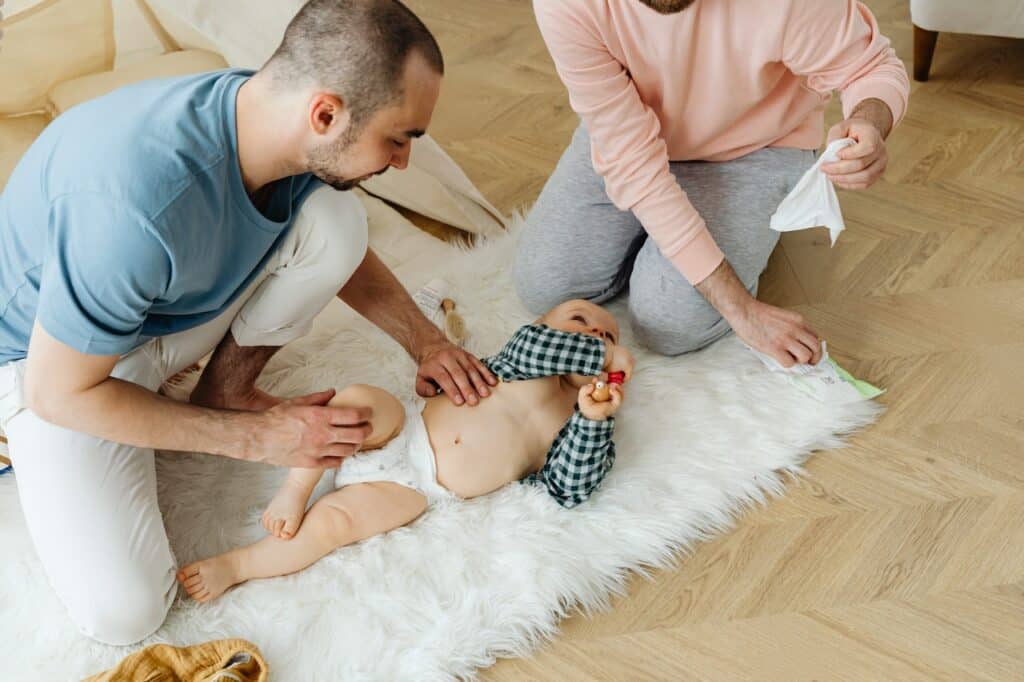
It is recommended to change a baby’s diaper as soon as possible after a bowel movement. If a baby is sleeping, it is still best to change their diaper promptly. Leaving a soiled diaper on for an extended period can lead to skin irritation and discomfort for the baby.
Solid foods can cause changes in bowel movements, leading to more frequent and larger stools. Parents should be mindful of this and change their baby’s diaper more frequently if necessary. Pampers and other diaper brands offer different types of diapers for different stages of a baby’s development, including those designed for solid foods.
Parents should also be aware of the signs that indicate a soiled diaper, such as a strong odor or a bulging diaper. Checking the diaper frequently and changing it as needed can help prevent discomfort and irritation for the baby.
In summary, changing a baby’s diaper promptly after a bowel movement is essential for maintaining good hygiene and preventing skin irritation and discomfort. Parents should be mindful of their baby’s bowel movements and check their diaper frequently to ensure they are clean and dry.
Conclusion
In summary, changing a sleeping baby’s diaper is a personal decision that ultimately depends on the parent’s preference and the baby’s needs. While some parents choose to let their babies sleep through the night without changing their diapers, others prefer to change them regularly to prevent diaper rash and discomfort.
It is important to note that leaving a wet or soiled diaper on for too long can lead to skin irritation and even infection. Therefore, parents should monitor their baby’s diaper and change it as soon as possible if it is wet or soiled, regardless of whether the baby is sleeping or awake.
Additionally, using high-quality diapers that are absorbent and comfortable can help minimize the need for frequent changes and reduce the risk of leaks and discomfort. Parents should also make sure to use gentle wipes and creams to clean and protect their baby’s delicate skin.
Overall, whether or not to change a sleeping baby’s diaper is a personal decision that should be based on the baby’s needs and the parent’s preferences. By staying attentive and proactive, parents can ensure their baby stays clean, comfortable, and healthy.
Related Posts:
Frequently Asked Questions
When should I change my baby’s diaper if they are sleeping?
It is recommended to change your baby’s diaper as soon as you notice it is wet or soiled. However, if your baby is sleeping soundly, it is not necessary to wake them up just to change their diaper. It is important to maintain good hygiene, but it is also important to let your baby sleep as much as possible.
What should I do if my baby poops while sleeping?
If your baby poops while sleeping, it is best to change their diaper as soon as possible to prevent skin irritation and infection. However, if your baby is sleeping soundly, it is not necessary to wake them up just to change their diaper. You can change their diaper when they wake up or during their next feeding.
How often should I change my 3-month-old’s diaper?
Babies at this age typically need to have their diapers changed every two to three hours, or more frequently if they have soiled their diaper. It is important to keep your baby clean and dry to prevent diaper rash and other skin irritations.
Should I change my baby’s diaper before or after feeding?
It is recommended to change your baby’s diaper before feeding them, as this can help prevent them from becoming too sleepy during feeding. However, if your baby has a dirty diaper during feeding, it is best to stop feeding and change their diaper before continuing.
How long can a baby wear a diaper at night?
Babies can wear a diaper at night for 8-12 hours, depending on their age and how much they sleep. It is important to change their diaper as soon as possible after they wake up, to prevent skin irritation and infection.
Can a wet diaper wake a sleeping baby?
A wet diaper can make a baby uncomfortable, but it is not likely to wake them up from a deep sleep. It is important to change their diaper as soon as possible when they wake up, to prevent skin irritation and infection.

Iesha is a loving mother of 2 beautiful children. She’s an active parent who enjoys indoor and outdoor adventures with her family. Her mission is to share practical and realistic parenting advice to help the parenting community becoming stronger.
